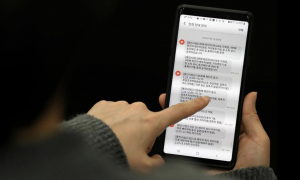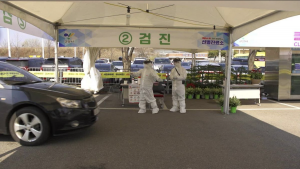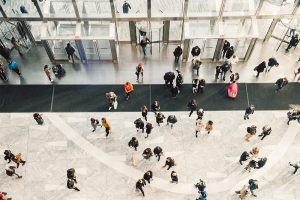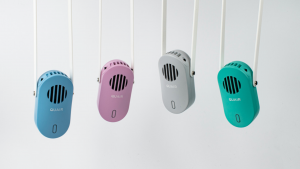For some, 2020 will always be remembered for the irruption of the COVID-19 pandemic, but here at TECNOCAL we would rather remember it as a year in which science, design, and technology came to the rescue to improve the tracking and monitoring of diseases, medical care, disease-spread prevention, and life in isolation forever. Below is a list of solutions illustrating how data accessibility, geolocation, robotics, design, and virtual reality helped our lives over the last year.
Geolocation done right: The development of contact-tracing apps.
Corea del Sur fue uno de los primeros gobiernos que intensificó el seguimiento del coronavirus online. It employed the use of technology to track the virus by sending alerts through text messages in real-time, online applications about the number of confirmed coronavirus cases, and the travel history of those infected. The Corona 100m (Co100), launched on February 11, 2020, had one million downloads in the first ten days. Today, more than 40 countries have implemented this technology to monitor contagion sources successfully.
Data ready: Real-time information available in dashboards.
In March 2020, The Boston Department of Innovation and Technology’s Citywide Analytics Team launched two dashboards for effective COVID-19 tracking in the city of Boston and state of Massachusetts.
The first dashboard includes a graph that visually displays the spread of Covid-19 in the state of Massachusetts and tracks daily updates of COVID cases from the Massachusetts Department of Public Health (MDPH).
The second dashboard includes information specific to Boston: daily cases, recovered, and total cases. It also tracks the number of tests performed in the US.
Considering the difficulty experienced by the World Bank and WHO to centralize this data on a global scale, the solution promoted by data experts is not only useful for the community but also replicable, at least in the US, where countless cities have incorporated it.
Mass testing: Extending scalable medical aid beyond medical practices.
The importance of reducing contact and concentration of people in medical care has led many countries to opt for testing solutions outside of hospitals. While some cities have installed tents to monitor symptoms, others moved the waiting room and testing to the patients' cars.
In March 2020, South Korea pioneered the invention ofDrive-through clinicstesting stations to protect both patients and medical workers during mass COVID testing. The process takes place in open-air parking lots, where patients drive into a testing site, and a medical worker in protective gear takes their temperature and performs the test. Over time, they implemented an additional solution to decrease contact between the medical worker and the patient by having them do their own swab.
Another innovation for mass testing still in development are portable test kits which create inexpensive and easily accessible options.
For the love of 5G, put on a mask! Chinese robots with 5G technology join the battle against coronavirus.
In March 2020, tech companies such as Keenon Robotics, Suiasun, and China Mobile donated robots to assist with tasks such as cleaning, disinfection, drug delivery, and even teleconferencing via 5G to avoid direct contact between doctor and patient. Additionally, robots in China patrol the streets to detect high temperatures and control the use of masks on public roads.
Guangzhou Gosuncn, a company that offers technological solutions for smart cities, modified a 5G police patrol robot by adding five high-resolution cameras and infrared temperature sensors to take the temperature of up to 10 people at a time within a 5-meter radius. Upon detecting a person with a high temperature or without a mask, the robot alerts the authorities. It also collects and transmits data to a control center, which offers large samples of updated data to assist in situational decision making. Robots can be driven autonomously or managed remotely, thus contributing to social distancing.
Avoiding crowds: Tech solutions designed to monitor client density in stores.
In Switzerland, Sensormatic developed a platform to help businesses protect their stores from the coronavirus. One solution in their portfolio is ShopperTrak, which allows stores to monitor customer density in real-time. Given that the virus is more likely to spread indoors, this solution is particularly relevant.
Clear the air: Solutions designed to clean the air we breathe.
COVID-19 has also inspired innovations that protect people from other afflictions such as allergies, pollution, and bacteria.
One solution that promises to improve our quality of life is the portable air purifier called the Quair Plasma Mini. Given the difficulty of purifying the air of an entire planet, Quair developed a lightweight and compact solution worn around the neck to protect people from major respiratory ailments. The Plasma Mini promises to purify the air three times more than competing products. Thanks to the bipolar ions, it strips viruses and bacteria of the hydrogen they need to survive.
Another development stems from the newest addition to our everyday wardrobe: the face mask. When confronted with the pandemic, MIT launched the #ReimagineMask challenge which offered designers and engineers a chance to reinvent it. The winning proposal is called Social MaskSocial Mask, a transparent mask designed by a Romanian industrial designer Burzo Ciprian. Connecting via Bluetooth to a mobile device, its sensors detect the wearer's body temperature, as well as microparticles and microorganisms that could enter the respiratory tract in real-time and sends an alert to the user's cell phone. Social Mask is made with polycarbonate and polypropylene using 3D printers. It is not only intended for use during the pandemic but also for people suffering from respiratory conditions in general.
Returning normalcy is at the top of everyone's mind. The American company, Armstrong, developed an interesting solution for offices and schools with their air containment and purification system, 24/7 Defend. Ceiling panels reduce air leakage while working with air purifiers and ultraviolet air purification technology to remove up to 97% of infectious particles in the air in the first use.
Fashion and Cosmetics: Imagining the new normal of retail..
Of course, we cannot ignore how, despite isolation, fashion has managed to imagine new modes of expression, and the future of fashion and cosmetics is in augmented reality.. Although this augmented reality has existed for a long time, the growing virtuality of work and social encounters has generated an explosion of filters, applications, and other technological solutions that enable companies to keep closer relationships with their clients.
This virtuality trend presents two orientations. One of which aims to bring the fitting room or a store consultant to the shopper's home.
Tech company Zeekit has developed a virtual fitting room with deep learning that can digitize and adapt any two-dimensional image of a garment to a photo of the customer's figure. Adidas and Bloomingdales are two leaders in retail that are already using this technology today.
In 2020, Vichy launched a virtual consultancy service called SkinConsultAI that reads live images on a webcam to find the most critical problems with a user's skin and recommend products.
The second orientation in fashion's growing virtuality consists of offering completely virtual products. We've already seen Snapchat and Instagram filters over the years, but now users can take advantage of virtual makeup and clothing for all kinds of occasions, including work meetings on Zoom. Imagine creating a professional look for Linkedin without ever having to visit a store!
A successful example of the first virtual fashion brand The Fabricant. Using an online platform called Leela, they dress clients as avatars with looks that can be used on social media, online games, or other virtual worlds. In 2019, The Fabricant made history by selling a virtual dress for $9,500 in an online auction.
In cosmetics, L'Oreal developed a virtual makeup line for video calls called Signature Faces. The filter is free, but the proliferation of filters in social networks suggests considerable business growth potential. An example of a profitable filter app is the selfie-editing startup FaceTune, which, in 2019, established itself as a unicorn by raising $205 million in funding. Unlike L'Oreal’s, FaceTune is not free but comes with various one-time, monthly, or yearly payment options.
Due to the pandemic, our realities have become intertwined with the world online. Due to ample growth in broadband mobile devices and cameras, visual communication is becoming increasingly more accessible. More companies are choosing to keep their employees remote, online education has grown exponentially, and work and social relationships have shifted. If we consider that social distancing will remain with us for a while longer, digital solutions can only strengthen our online presence and professional brand.
Sources:
- AngelList: https://angel.co/newsletters/selfies-are-the-future-158
- Armstrong Ceilings: https://www.armstrongceilings.com/commercial/en-us/performance/defend-portfolio.html?itid=Defend-FeatArticleCard-TXT-defend
- CNN: https://edition.cnn.com/2020/03/02/asia/coronavirus-drive-through-south-korea-hnk-intl/index.html
- CTV News: https://www.ctvnews.ca/health/south-korea-takes-fast-food-approach-to-covid-19-testing-1.4835570
- DesignBoom: https://www.designboom.com/technology/social-mask-burzo-ciprian-mit-pandemic-response-11-25-2020/
- The Fabricant: https://www.thefabricant.com/
- FierceBiotech: https://www.fiercebiotech.com/medtech/oxford-researchers-develop-portable-covid-19-test-costing-less-than-25
- Forbes: https://www.forbes.com/sites/solrogers/2020/02/19/is-immersive-technology-the-darling-of-the-fashion-world/?sh=6ce41fd2256c
- TheGadgetFlow: https://thegadgetflow.com
- Hipertextual: https://hipertextual.com/2020/02/coronavirus-china-robots-5g
- Indiegogo: https://www.indiegogo.com/projects/quair-plasma-mini-wearable-air-purifier#
- ShopperTrak: https://www.shoppertrak.com/occupancy
- Smartcities: https://www.smartcitiesworld.net/news/news/south-korea-to-step-up-online-coronavirus-tracking-5109
- Smartcities: https://www.smartcitiesworld.net/news/boston-launches-covid-19-data-dashboards-for-residents-5161
- Smartcities: https://www.smartcitiesworld.net/news/how-5g-powered-robots-are-helping-china-fight-coronavirus-5154
- Springwise: https://www.springwise.com/innovation/retail/shoppertrak-real-time-occupancy
- Springwise: https://www.springwise.com/sustainability-innovation/fashion-beauty/the-fabricant-virtual-clothing
- Techcrunch: https://techcrunch.com/2020/11/12/loreal-rolls-out-a-line-of-virtual-makeup/
- Vichy USA: https://www.vichyusa.com/skin-care-analysis-ai.html
- Wikipedia: Covid-19 Apps: https://en.wikipedia.org/wiki/COVID-19_apps#List_of_countries_with_official_contact_tracing_apps
- Zeekit: https://zeekit.me/








